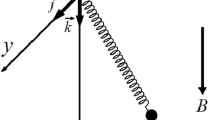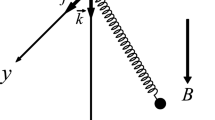Abstract
A resonant pulse transformer with shock excitation is compared with a system of coupled pendulums with different masses tuned to resonance. For the Tesla transformer and coupled pendulums, conditions for complete energy transfer during one-half of the beat cycle were obtained. The requirements for the system parameters and initial conditions necessary for complete transfer of energy in the case of two spring-coupled pendulums with different masses and of the same length were first determined theoretically and then verified experimentally. The dependence of the minimum time for complete transfer of energy from one pendulum to the other on the system parameters is obtained.




Similar content being viewed by others
REFERENCES
N. Tesla, “System of Electrical Lighting", US Pat. 454622. Publ. 23.06.1891.
N. Tesla, “Apparatus for Producing Electrical Current of High Frequency and Potential," US Pat. 568176. Publ. 22.09.1896.
A. Oberbeck, “Ueber den Verlauf der Electrischen Schwingungen bei den Tesla’schen Versuchen," Ann. Phys. Chem. Bd 55, 623–632 (1895).
P. Drude, “Uber Inductive Erregung Zweier Electrician Schwingungskreise mit Anwendung auf Perioden und Dampfungsmessung, Tesla Transformeren und Draftlose Telegraph," Ann. Phys. Bd 13, 512–561 (1904).
W. Heise, “Tesla-Transformatoren," Electrotech. Z. Bd A-1 (7), 1–8 (1964).
E. A. Abramyan, “High-Current Transformer Accelerators," Preprint No. 17-70 (Institute of Nuclear Physics, Siberian Branch, USSR Academy of Sciences, Novosibirsk, 1970) [in Russian].
S. B. Wasserman, “Tesla Transformer in High-Voltage Charged Particle Accelerators," Preprint No. 77-110 (Institute of Nuclear Physics, Siberian Branch, USSR Academy of Sciences, Novosibirsk, 1979) [in Russian].
L. I. Mandel’shtam, Lectures on the Theory of Oscillations (Nauka, Moscow, 1972) [in Russian].
V. V. Korochentsev, V. S. Pechnikov, and V. V. Zautkin, Oscillations of Coupled Pendulums (Far Eastern Federal University, Vladivostok, 2013) [in Russian].
A. A. Balyakin and N. M. Ryskin, Oscillations in Systems with Several Degrees of Freedom. Oscillations in Distributed Systems (Saratov State University, Saratov, 2008) [in Russian].
Author information
Authors and Affiliations
Corresponding author
Additional information
Translated from Prikladnaya Mekhanika i Tekhnicheskaya Fizika, 2021, Vol. 63, No. 4, pp. 18-26. https://doi.org/10.15372/PMTF20220402.
Rights and permissions
About this article
Cite this article
Palchikov, E.I., Tarasova, E.E. & Tarasova, I.E. COUPLED PENDULUMS AS A MECHANICAL MODEL OF THE TESLA TRANSFORMER. J Appl Mech Tech Phy 63, 566–573 (2022). https://doi.org/10.1134/S0021894422040022
Received:
Revised:
Accepted:
Published:
Issue Date:
DOI: https://doi.org/10.1134/S0021894422040022




